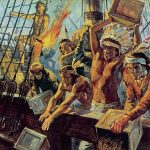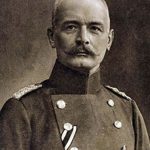
The irony of a Vichy gendarme saluting a Nazi official before the Arc de Triomphe / es-wikipedia-org
Three-fifths of France fell to Nazi Germany soon after World War II was declared, though the French army and navy were larger than those of the aggressive Germans. The government moved to a spa town in unoccupied France called Vichy, and on the 10 July, 1940 the National Assembly authorized (by a vote of 569 to 80) the assumption of full powers by the elected Prime Minister, a hero of the First War called Marshal Pétain, pending promulgation of a new constitution.
Later on that day, notwithstanding, Pétain declared himself ‘Head of the French State’, and thus began four years of administration by this autocratic ‘interim’ regime. Since Paris was occupied by the Germans, with their Western Front HQ set up there, Vichy continued to be used as the temporary ‘French capital’. The Third Republic was abolished.
The Vichy Government was never recognised by the Allies, and was in fact treated by them as an enemy. Vichy assisted the Nazis in every recognizable way, including the arrest of members of the resistance or Jews, and their subsequent execution, or transportation to Eastern concentration camps. Allied spies or troops in France compared the Vichy secret police to the Gestapo. Escaped Allied prisoners of war were shot by the French authorities. In 1941 Vichy granted Japan right of access and air bases in French Indo-China, from which Japan could launch both her Malayan and Burmese invasions.
Though the old Marshal was officially the President, the Vichy Government was in reality controlled by his deputy, Pierre Laval (1940); and later by François Darlan (assassinated 1942), who collaborated directly with Adolf Hitler, and after his death once more by Laval as Pétain’s successor after the Germans moved militarily into the previously unoccupied part of France.
The Allies invaded Normandy in 1944 and began the liberation of occupied France. The Vichy Government hastily moved itself to Sigmaringen in Germany, but it collapsed when Germany surrendered in 1945.
Pierre Laval, who had activated support for Hitler, forced young French men and women into unpaid labour in Germany, authorized a French fascist militia, and instituted a reign of terror throughout France, was caught, tried by the French and shot in 1945. He was fifty-two.
Henry-Philippe Pétain, who had been a military hero for stopping the German advance at Verdun in 1916, and was the French commander-in-chief in 1917, must have suffered failing mental powers, since he had tried to collaborate with both the Allies and Nazi Germany. The French sentenced him to death as a collaborator in 1945, but the sentence was commuted to life imprisonment personally, by General de Gaulle. He died at the age of ninety-five, in 1951.










[…] seek only to accept whatever scraps their true masters on the left will throw them. They are the Vichy French, the Quislings, and the Benedict Arnolds of the present […]
[…] seek only to accept whatever scraps their true masters on the left will throw them. They are the Vichy French, the Quislings, and the Benedict Arnolds of the present […]